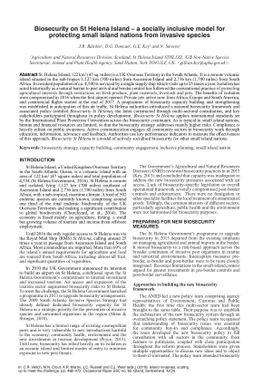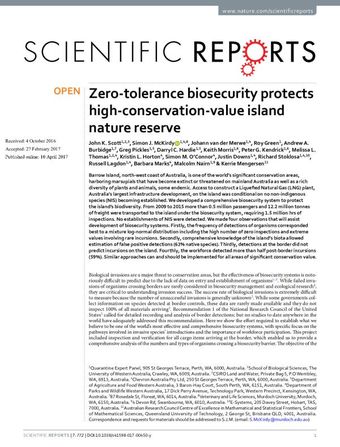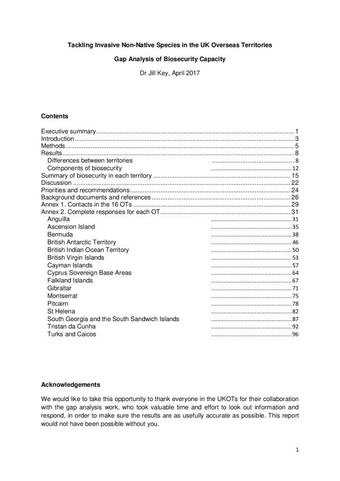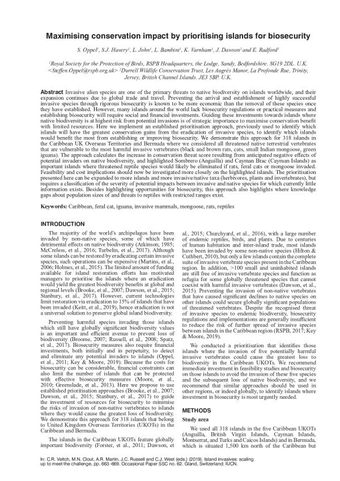Biosecurity on St Helena Island a socially inclusive model for protecting small island nations from invasive species
- Description:
- St. Helena Island, 122 km2 (47 sq. miles) is a UK Overseas Territory in the South Atlantic. It is a remote volcanic island situated in the sub-tropics 1,127 km (700 miles) from Ascension Island and 2,736 km (1,700 miles) from South Africa. Its resident population of ca. 4,500 is serviced by a single supply ship which visits up to 25 times a year. Isolation has acted historically as a natural barrier to pest arrival and border control has followed the conventional practice of protecting agricultural interests through restrictions on fresh produce, plant materials, livestock and pets. The bene?ts of isolation were compromised in 2016 when the ?rst airport opened. Private jets arrive now from Africa, Europe and South America, and commercial ?ights started at the end of 2017. A programme of biosecurity capacity building and strengthening was established in anticipation of this air tra?c. St Helena authorities introduced a national biosecurity framework and associated policy (entitled Biosecurity St Helena), the latter constructed through multi-sectoral consultation, and key stakeholders participated throughout in policy development. Biosecurity St Helena applies international standards set by the International Plant Protection Convention across the biosecurity continuum. As is typical in small island nations, human and ?nancial resources are limited, so that the biosecurity strategy addresses mainly higher risks. Compliance is heavily reliant on public awareness. Active communication engages all community sectors in biosecurity work through education, information, advocacy and feedback. Authorities use key performance indicators to measure the e?ectiveness of this approach. Biosecurity St Helena is a model of actively socialised biosecurity for other small island nations.
- Display date:
- 2019
- Collections:
- Secretariat of the Pacific Regional Environment Programme (SPREP)
- Publisher:
- International Union for Nature Conservation (IUCN)
- Content partner:
- Secretariat of the Pacific Regional Environment Programme (SPREP)
- Availability:
- Not specified
-
Copyright status: All rights reservedFind out more about what you are able to do with this itemThis item is all rights reserved, with means you'll have to get permission from Secretariat of the Pacific Regional Environment Programme (SPREP) before using it. For more information, please see our use and reuse page.What can I do with this item?Non-infringing useNZ copyright law does not prevent every use of a copyright work, and this item may be hosted by an international institute or organisation. You should consider what you can and cannot do with a copyright work.No sharingYou may not copy and/or share this item with others without further permission. This includes posting it on your blog, using it in a presentation, or any other public use.No modifyingYou are not allowed to adapt or remix this item into any other works.No commercial useYou may not use this item commercially.
Related items
Welcome and warm Pasifik greetings
The information on this site has been gathered from our content partners.
The names, terms, and labels that we present on the site may contain images or voices of deceased persons and may also reflect the bias, norms, and perspective of the period of time in which they were created. We accept that these may not be appropriate today.
If you have any concerns or questions about an item, please contact us.



